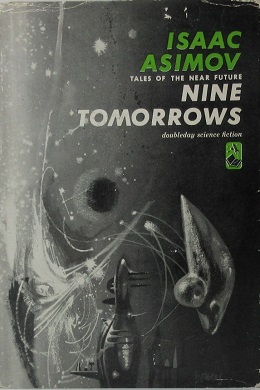Read this short story for free online here, or hear Isaac Asimov read it to you here on youtube.
1. This is a nine page series of seven flash fiction episodes that are repeated cyclical events. Each is different enough to stay interesting and the whole is short enough to not get repetitively boring. This formulaic, episodic repetition is well done and each episode gives merely a glimpse of the surrounding context. But each glimpse is a meaningful, important one, packed with ideas of future human evolution that allows the story to expand in the reader's imagination outside of the words on the page.
2. Like in "Nightfall", Asimov starts with the familiar, but then walks off through stages into theoretical post-matter humans and finally to the fantastic realization of a creative god. But this end is still tinged with familiarity from Biblical creation. This is a large chunk of time and evolutionary change to bite off in one short story, or seven flash-fictions, but Asimov pulls it off through this structure. It's courageous of Asimov to take a nine page short story and further fragment it into seven connected shorter stories over this much time and change. That he was successful clearly shows his immense skill as a storyteller. It's astoundingly well crafted throughout.
3. Because I think this is so well constructed, I'm going to list all seven episodes and the scene, plot, and revelation about future humanity. One: familiar humans are confined to their own solar system when two computer techs get drunk on a night-watch. Two: a human family emigrating to another star in the Milky Way arrives at their destination planet. Three: humans can now harness sun power and they have almost overpopulated the Milky Way, while two people try to assemble a political report to a committee. Four: humans are still tied down to matter via bodies in immortal stasis, but their consciousnesses roam the almost overpopulated universe free of their body, as two explorers seeking newness only for their own pleasure run into each other and converse philosophically. Five: Man is now a unified consciousness, floating outside of the bodies in stasis, still unable to solve the repeating ultimate question, and realizing it as an imminent whole for the first time. Six: Man's minds fuse with the computer, transfer their consciousnesses as the galaxies end, in stasis bodies die off of heat-death. Seven: the computer starts the process all over again after solving the question. The episodes are given variety through their uniqueness, but theme and connection through the repeated question and answer. This is great structure, both communicating the inevitability of that first drunken bet, and seeing it through to the end.
4. The writing is okay, again. Tight, explanatory narrative only—which he is skillful at here. The writing's directness helps the whole stay focused appropriately. I think that first line is good, especially in relation to the story to come. Overall there is nothing great, nothing terrible. But really, what is possible in flash-fiction other than efficiency and
maybe one witty thought? Well here he has three witty thoughts spread
across seven episodes, one of which is repeated in six episodes, and that's not bad. The characters, as in most flash fiction, are necessarily two dimensional to keep everything so tightly focused.
5. It might be a plot hole that humanity is a single mind in episode five, but then multiple again in six.
6. I think there are three themes: that humanity doesn't know the side effects of what it creates, that humanity never focuses its efforts on something until it's too late, and that history is cyclical. Here, the perpetually self-improving computer eventually allows people to focus solely on personal pleasure while the computer's improvement seems to pass out of the understanding of the humans in the story; then it unexpectedly restarts all of universal history, giving humans another cycle. Humanity meanwhile, for all its physical changes, doesn't really change that much mentally and is still eminently capable of ignoring the onrushing train. The third theme is created directly from the story structure, the repetition of the question and answer, and the computer's action and words at the end.
7. The lack of tangential discourse, the cyclical repetition, and the two dimensional characters allow the short story to stay incredibly focused and tight. But melded to that is information about human development that answers just enough questions to give the story import: some of the necessities for these large changes are briefly and logically explained as overpopulation. The more fantastic changes are simply explained as facts—and they're familiar to science fiction, so they're not too big of imagination stretchers. But by exploring them through these varied episodes—all short and direct enough to stay engaging—they are shot through with uniqueness enough to make the whole story memorable and believably familiar.





No comments:
Post a Comment